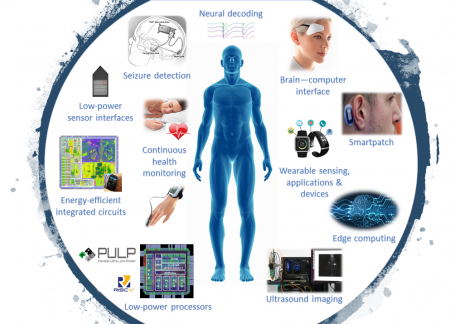Difference between revisions of "Biomedical Circuits, Systems, and Applications"
From iis-projects
(Replaced content with "thumb|right|450px") |
|||
| Line 1: | Line 1: | ||
[[File:iis-project-image.png|thumb|right|450px]] | [[File:iis-project-image.png|thumb|right|450px]] | ||
| + | |||
| + | Research on biomedical sensing systems and signal processing algorithms has been very prolific in recent years with a variety of solutions in a wide range of application scenarios, for example long-term monitoring of human vital signs for disease detection. Low-power consumption and energy efficiency are the key features of such systems starting from the sensor node, data acquisition, data handling, and processing. | ||
| + | |||
| + | <!-- | ||
| + | |||
| + | There are many examples of implemented and deployed wearable devices that attempt to exploit intelligent sensing to monitor human vital signs and activities. The main challenges of wearable design are to prolong the operating lifetime and to enhance usability, maintenance, and mobility, while keeping a small and unobtrusive form factor. | ||
| + | Unlike other sensing systems, mobile and wearable sensing systems have to provide continuous data monitoring, acquisition, processing, and classification. Supporting such continuous operation using only ultra-small batteries poses unique challenges in energy efficiency. The other major challenge for mobile sensor systems is to be able to understand the world in a similar way as humans do. Perceptive low-power sensor devices should be able to interpret the context around their users and allow context-aware multi-agent interaction. Machine learning approaches, in particular deep learning techniques, show great promise toward achieving this goal. | ||
| + | |||
| + | Wearable devices for biomedical applications are becoming more and more pervasive. The push towards the wearable Internet of Things (IoT) requires devices that are flexible enough to be adapted for different applications while being limited by available power for the overall system. A new generation of IoT and smart sensing systems should not only provide continuous data monitoring and acquisition, but are also expected to process and make sense of the acquired data in similar ways as human experts do. Supporting continuous data analysis capabilities on ultra-small batteries poses unique challenges in energy efficiency on both hardware and software. | ||
| + | |||
| + | Data analytics and classification problems are increasingly tackled with machine learning approaches, featuring many stages of feature extractors and classifiers with lots of parameters that are optimized using the unprecedented wealth of data that has recently become available. Advanced ML techniques, such as deep learning, are achieving impressive results, starting to outperform humans on very challenging problems and datasets. However, most of these approaches are still not suitable for low-power battery operated devices (and even less for wearable, ultra-miniaturized devices) because, in their current embodiment, they require massive amounts of computational power. | ||
| + | |||
| + | The present research project aims to push beyond the current power walls for machine learning and bio-signal processing and move toward milli-watt (or even micro-watt) continuously active, long-term wearable biomedical systems. This requires working on algorithms, architecture, circuits as well as designing methods for these new promising embedded and wearable devices with artificial intelligence capability under extreme constraints: tiny energy buffers (batteries), miniature energy harvesters providing tiny amounts of energy, low-power sensors, and interfaces. Specifically the project aims at studying and developing ML-based bio-signal data analysis algorithms suitable for ultra-low power wearable devices and to demonstrate hardware-software integration in a prototype smart patch with | ||
| + | multi-lead ExG advanced embedded analytics and classification capabilities within a power envelope of | ||
| + | a few mW. | ||
| + | |||
| + | |||
| + | ---> | ||
Revision as of 13:25, 11 November 2020
Research on biomedical sensing systems and signal processing algorithms has been very prolific in recent years with a variety of solutions in a wide range of application scenarios, for example long-term monitoring of human vital signs for disease detection. Low-power consumption and energy efficiency are the key features of such systems starting from the sensor node, data acquisition, data handling, and processing.
